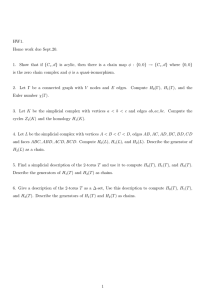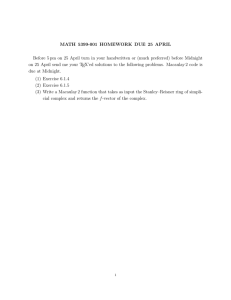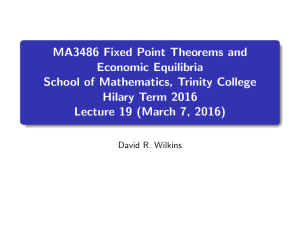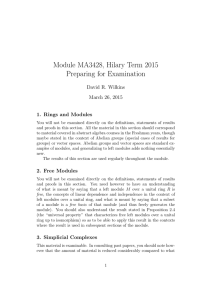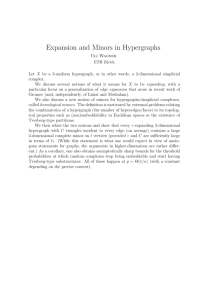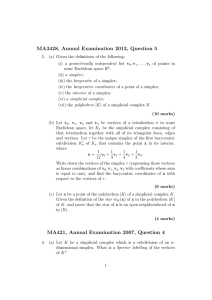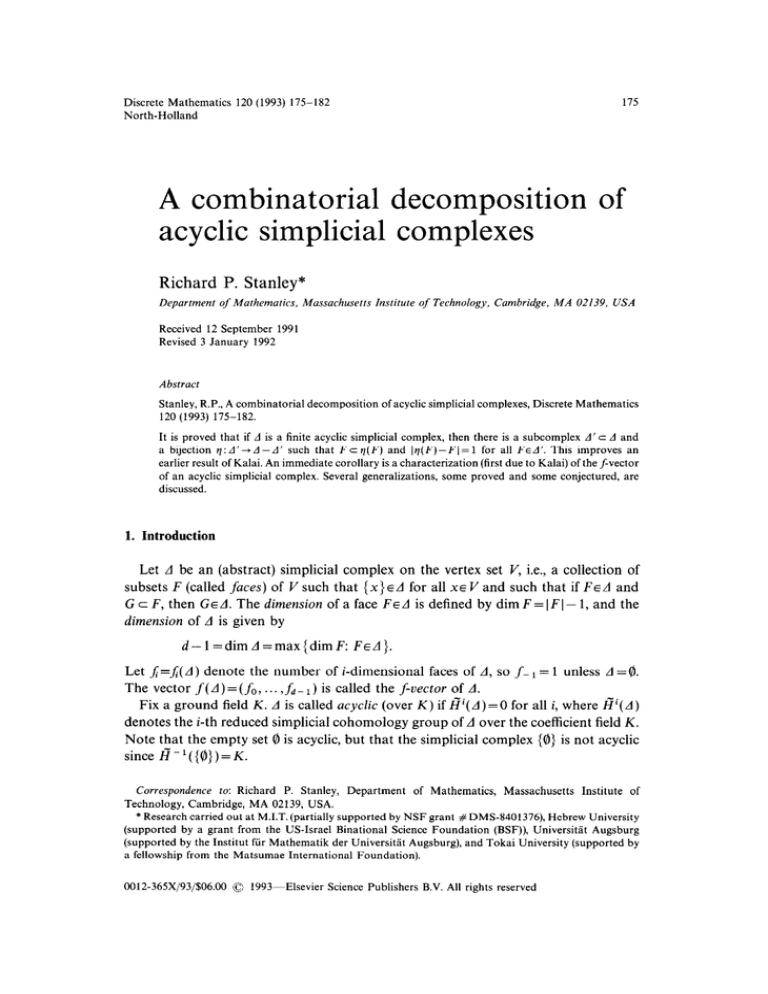
Discrete Mathematics
North-Holland
175
120 (1993) 175-182
A combinatorial decomposition
acyclic simplicial complexes
Richard
of
P. Stanley*
Department of Mathematics, Massachusetts Institute of Technology, Cambridge, MA 02139, USA
Received 12 September 1991
Revised 3 January 1992
Abstract
Stanley, R.P., A combinatorial
120 (1993) 175-182.
decomposition
of acyclic simplicial
complexes,
Discrete Mathematics
It is proved that if d is a finite acyclic simplicial complex, then there is a subcomplex
d’ c d and
a bijection q:d’+d-d’
such that Fcq(F)
and /q(F)-FJ=l
for all FEN’. This improves an
earlier result of Kalai. An immediate corollary is a characterization
(first due to Kalai) of the f-vector
of an acyclic simplicial complex. Several generalizations,
some proved and some conjectured,
are
discussed.
1. Introduction
Let A be an (abstract) simplicial complex on the vertex set V, i.e., a collection of
subsets F (called faces) of V such that { X}EA for all XE V and such that if FEA and
G c F, then GE A. The dimension of a face FEA is defined by dim F = 1F I- 1, and the
dimension of A is given by
d-l=dimA=max{dimF:
FEA}.
Let ff=fi‘( A) denote the number of i-dimensional
faces of A, so f_ 1 = 1 unless A =8.
The vector f(A) = ( fO, . . . ,fd _ 1) is called the f-vector of A.
Fix a ground field K. A is called acyclic (over K) if &‘( A)=0 for all i, where I?‘( A)
denotes the i-th reduced simplicial cohomology group of A over the coefficient field K.
Note that the empty set cbis acyclic, but that the simplicial complex (8) is not acyclic
since d-‘({O})=K.
Correspondence to: Richard
P. Stanley, Department
of Mathematics,
Massachusetts
Institute
of
Technology,
Cambridge,
MA 02139, USA.
* Research carried out at M.I.T. (partially supported by NSF grant #DMS-8401376),
Hebrew University
(supported
by a grant from the US-Israel Binational
Science Foundation
(BSF)), Universitgt
Augsburg
(supported by the Institut fiir Mathematik
der Universitit
Augsburg), and Tokai University (supported by
a fellowship from the Matsumae International
Foundation).
0012-365X/93/$06.00
0
1993-Elsevier
Science Publishers
B.V. All rights reserved
176
R.P. Stanley
A special class of acyclic simplicial
are cones. If d ’ is a simplicial
complexes
complex
on v’, and if x is a new vertex not in V’, then the cone d =x * A’ (the join of A’ with the
vertex x) is defined
to be the simplicial
A=x*A’=A’u{{x}uF:
Note
q(F)=Fu
the
following
complex
FEA’}.
property
of
(x}. Then q is a bijection
the
cone
x * A’:
from A’ to A -A’
(Pl) The domain A’ of y is a subcomplex
of A.
(P2) For all Fed’, we have q(F)=, F and Iv(F)-FI=
An immediate
corollary
to these properties
(P3) There exists a simplicial
complex
r: A’+
Define
A-
A’
by
satisfying:
1.
is the following:
A, such that
+x1 1 uL,(Ao)x’.
i~oLOxi=(l
iB0
Of course the simplicial complex A, of (P3) is just A’. We can ask whether for any
acyclic simplicial complex A there is a subset A’ c A and bijection 4 : A’ -+ A -A’
satisfying (Pl)-(P3).
Kalai [8], using his technique of algebraic shifting, first proved
(P3). Bjorner and Kalai [3,4] went on to give a vast generalization
of this result.
Meanwhile Kalai (private communication)
found a proof of (P2) based on algebraic
shifting, and asked whether (Pl) was also true. In this paper we will prove (Pl) (as well
as (P2) and hence (P3)) using a somewhat simplified variant of Kalai’s methods. In
particular,
though we work in the exterior algebra as does Kalai, we do not use
algebraic shifting.
Let r be a directed graph with vertex set V= {x i, . . , x,}. Recall that a one-factor of
r is a collection {e,, . . , e,} of edges which are not loops and such that every vertex is
incident to exactly one of the edges. (Thus n=2m.) The following lemma is closely
related to but not a direct consequence
of [S, Thm. 2.11 [12, Thm. 6.21.
Lemma 1.1. Let r be a directed graph on the n-element vertex set X. Let KX be the
K-vector space with basis X. Suppose there is a linear transformation cp : KX + KX
satisfying the two properties:
(a) Zf XEX then
cp(x)Espan,(
yEX: (x, y) is an edge ofr).
(b) im cp= ker cp. (Equivalently
Then r has a one-factor
a basis for KX/(im
X’=
{x~X:
cp is nilpotent with all Jordan
Y. In fact, ifX’
cp), then Y can be chosen
(x,y)EY
i.e., X’ is the set of initial
blocks of size two.)
is a subset of X whose image in KX/(im
cp) is
so that
for some yEX},
vertices
of the edges in Y.
Proof. Let X’ be a subset of X whose image in KX/(im cp) is a basis for KX/(im cp).
Since for any cp: KX -+ KX we have dim(ker cp)+dim(im cp) = n, there follows
Acyclic simplicial complexes
117
IX’1 =1X-X’I=n/2.
By the Marriage Theorem (e.g., [l, Thm. 2.2.11 [11, Ch. 5,
Thm. 1.11) it suffices to show that for any S G X’, say with ISI = k, there are (at least)
k vertices yi, . . . , ~,EX - X’ such that for each 1 did k there is an XES with (x, yi) an
edge of r. Suppose not. Let S={xl,...,xk}.
Then cp(xi),...,cp(x,)
are linearly
dependent in KXIKX’, since they are all in the span of fewer than k vertices of r. Thus
some linear combination
kercp=imq,
and xi,...
a contradiction.
a, x1 + ... + akxk (a+K,
, xk are linearly
not all ai =0) belongs
independent
im cp. Hence
all ai =O,
0
Theorem 1.2. Let A be an acyclic simpliciul complex
A’ c A and a bijection q : A’ + A -A’
and /q(F)-FI=l.
exists a subcomplex
Fcq(F)
modulo
to ker cp. But
over some jield K. Then there
such that for all FE A’ we have
Proof. Let C’ be the space of i-cochains of A (i.e., the K-vector
the set of i-dimensional
faces of A). Let
. . . -&-
()+c-l2+cO~
L
cd-l+0
space KA’, where A i is
(1)
be the augmented
oriented cochain complex used to define the reduced simplicial
cohomology
of A. Let C= KA= C-’ 0 ... 0 Cd-l. The coboundary
maps 6’ define
an overall coboundary
map 6: C-+ C. The statement
that A is acylic over K is
equivalent to (1) being exact, i.e., ker 6 = im 6.
Suppose A has vertex set I’= { vl, . . . , v,}. Let A( K V) denote the exterior algebra of
the vector space K V. For simplicity we denote the product in /1( K V) by juxtaposition,
rather than the more customary
A. Let Id denote the two-sided ideal of /1( K V)
generated by all monomials
vi1 ... Vi, where (vi,, . . . ,q,}$A.
The quotient
algebra
/i[ A] :=A(K V)/ld is called the exterior face ring of A (over K). It has a K-basis
consisting
of
all
face
monomials
VF :=Vi,
“’
Vi,,
where
il < ... <i,
and
F = { vi17. . . , v,}EA. (In particular,
aO= 1.) Thus we may identify as a vector space
/1[ A] with C, by identifying xF~n [A] with FEC. The coboundary
map 6 : C + C
then becomes right multiplication
by the element v = v1 + v2 + ... + v, of /1[ A].
Consider the quotient space Q = (1 [Al/A [A] v g C/(im 6), where n [A] v denotes
the right ideal {xv: x~/l[ A] >. (Actually, /i [ A] v is a two-sided ideal and the space
Q has the structure of a ring, but we do not need this fact here.) Let L be the
lexicographically
least basis (analogous to the definition of the basis M in the proof of
[ 14, Thm. 2.11) of Q consisting of face monomials
xF, with respect to the ordering
v1 <...<v,
of the vertices of A. Thus if GEA and xG$L, then we have a linear
relationship
xG=ulxF1+
. ..+atxF’+yv
(2)
in /1[ A], where y~/i[ A], aiE K, and each Fi< G (in the lexicographic
order just
defined). Let A’={FEA:
x~EL}. We claim that A’ is a subcomplex
of A. This is
a standard
argument,
first done in the context of quotients
of polynomial
rings
178
R.P. Stanley
by Macaulay
to show
xFeGxFi=
(see [ 14, Thm.
earlier (in lexicographic
xF$A’
2.11). Namely,
suppose
xF$L.
Multiply
(2) on the left by
fxcFmGjuFi,
we obtain an expression
:.s desired,
order) monomials
so A’ is a simplicial
x(~-‘)
xG$L
and F 1 G. We need
xFmG. Since in A[A]
we have
for xF as a linear combination
of
“Fi modulo
the space K [A] v. Hence
complex.
Now let r be the directed graph whose vertex set is A, and whose edges are the pairs
(F,G)
with Fc
the coboundary
GEA and IG-FI=l.
operator
Define
cp:KA+KA
by (p=6.
6, we have that cp satisfies condition
By definition
(a) of Lemma
(b) holds since A is acyclic. We can take X’= A’ in Lemma 1.1 by the definition
Thus by Lemma 1.1 A has a one-factor
Y = {(F, G): FEA’}, so we can
q:A’+A-A’by
q(F)=G,
where (F,G)EY.
of
1.1, while
of A’.
define
0
Corollary 1.3 ([S]). Fix a field K. Let (fo, . . . , fd_ l)~Zd. The following conditions are
equivalent:
(a) There exists a (d - 1)-dimensional acyclic (over K) simplicial complex A with
f(A)=(fo>
. ..&-I).
(b) There exists
a (d-2)-dimensional
simplicial
complex
A’
whose
f-vector
. . . ,f A_*)is given by
f(A’)=(fb,
d-2
(1+x)
d-l
frxi=i&f;xi.
c
i=O
The Kruskal-Katona
theorem
gives an explicit
characterization
of the f-vectors
(fb,....fh_2)arising in (b) above. See e.g. [l, Ch. 7.33, [7, Thm. 8.53.
2. Variations
and generalizations
There are many
possible
directions
for extending
Theorem
1.2. We discuss in this
section some of the possibilities.
For the most interesting
ones we can only offer
conjectures and not proofs. I am grateful to A. Bjorner, G. Kalai, and J. Munkres for
helpful discussions related to the work in this section.
First we can ask whether there is a generalization
of Theorem 1.2 valid for any
simplicial complex. We regard the field K as fixed throughout.
Given any simplicial
complex A, a Betti set is a subset B E A such that for all i,
# {FEB: dimF=i}=Fi(A).
Here
P”,(A)=dimE?‘(A;
the i-th reduced
K),
Betti number
of A (over K).
Aqdic
Proposition 2.1. Any (finite)
A=A’wBwQ
where:
179
simplicial complexes
simplicial
complex
A can be written as a disjoint union
(a) A’ is a subcomplex of A,
(b) B is a Betti set,
(c) A’u B is a subcomplex of A,
(d) there exists a bijection
q : A’ +Q such that for all FEA’ we have F c q(F) and
Iv(F)-F/=1.
Proof (sketch).
The proof is a simple extension
of the proof of Theorem
1.2. Using
notation from that proof, let L be the lexicographically
least basis of A[A]/(ker 6)
consisting of face monomials
xF. Let M be the lexicographically
least set of face
monomials
for which Lu M is a basis of A [A]/(im 6). Choose A’= { FEA: xF~L},
B= {Fed: x’EM}.
By definition of fi’(A; K) it follows that B is a Betti set, while
assertions
(a) and (c) follow by reasoning
similar to that used in the proof of
Theorem 1.2. 0
Unfortunately
Proposition
2.1 is not a satisfactory generalization
of Theorem 1.2,
because it is not strong enough to imply the BjiirnerKalai
characterization
[3,4] of
pairs (f; /J) such that f is the f-vector and p the sequence of Betti numbers of some
simplicial complex. The result actually needed (as first observed by Kalai) is the
following’.
Conjecture 2.2. The Betti set B in Proposition
rif F, GEB and F c G, then F = G.
Another
result.
Proposition
conjectured
generalization
2.3. Fix an integer
2.1 can be chosen to be an antichain, i.e.,
of Theorem
k30.
1.2 is motivated
The following
conditions
by the following
are equivalent
on
a vectorf=(f&
. ..&I).
(a) There exists a simplicial complex A with f-vector f such that if FEA and )FJ <k,
then lk(F) is acyclic. Here lk(F) denotes the link of F in A.
(b) There exists a simplicial complex on the vertex set V with f-uectorfsuch
that $
WC V and / V- WI < k, then the restriction Aw of A to W is acyclic.
(c) There exists a simplicial complex A’ with f-vector (fb,f;,
. . . ,fL_k_2)
such that
Proof. (a) o (b) Straightforward
(c) =S (a) Let cr be a k-simplex
1 Conjecture
2.2 was proved
topological argument.
and take A = 0 * A’ (the join of 0 and A ‘).
by Art Duval
after this paper was completed
180
R.P. Stanley
(a) a(c)
Let r be the simplicial complex obtained from A by algebraic shifting
(over the field K), as described in [3, Thm. 3.11 (but with a different notation). I am
grateful
to G. Kalai
for informing
me that algebraic
that lk (F) is acyclic for all FEN satisfying
shifting
preserves
the property
1F 1d k, so r also has this property.
It is easy
to see that any shifted complex (as defined in [3]) with this property is the join of the
simplex ~=2i’~2s...3k+11 with another simplicial complex d ‘. Since r is shifted and
f(d)=f(r)
[3, Thm. 3.11, we have
as desired.
0
Note. It is easy to see, without using any algebraic machinery, that if A satisfies the
condition
of Proposition
2.3(a) then the polynomial
F(x)=Cfi-1x’
is divisible by
(l+X)k+‘.
But we do not see how to show without algebraic shifting even that the
quotient F(x)/(l +x)~+I has nonnegative
coefficients.
The ‘simplest’ example of a simplicial
complex A satisfying the condition
of
Proposition
2.3(a) is just the join 0 * A’ used to prove (c) *(a). In this case A (regarded
as a poset under inclusion) can be partitioned
into intervals [F, G], FEA’, each of
length k+ 1. Moreover, the bottom elements F of these intervals form a simplicial
complex (namely, A’). This motivates the following conjecture.
Conjecture 2.4. Let k and A be as in Proposition
2.3(a). Then A can be partitioned
into
disjoint intervals [F, G], all of length k + 1. Moreover, the bottoms F of these intervals
form a subcomplex
A’ of A.
There is a further and well known conjecture concerning partitioning
of simplicial
complexes A [15, p. 1491 [6, Rmk. 5.21. Namely, if A is CohenMacaulay
then it can
be partitioned
into disjoint intervals [F, G] such that the tops G of these intervals are
all facets of A. We may extend this conjecture as follows: Suppose depth K[A] =6,
where K [A] denotes the face ring (or Stanley-Reisner
ring) of A. (A topological
description of depth K [A] is given by Munkres [ 10, Thm. 3.11.) Then (conjecturally)
A can be partitioned into disjoint intervals [F, G] such that the tops G of these intervals
satisfy dim G>6. We can combine this conjecture with Conjecture 2.4 as follows.
Conjecture 2.5. Suppose A satisfies the condition of Proposition
2.3(a), and let depth
K [A] =a. Then A can be partitioned
into disjoint intervals [F, G] satisfying:
dimG36,
dimG-dimF=k+l.
Let us now consider some generalizations
of the concept of simplicial complex itself.
There are three successively more general classes of complexes with which we will be
concerned. All these complexes are always assumed to be finite.
181
Acyclic simplicial complexes
(A) CW-semilattices,
or equivalently,
regular
section of two closed cells is a closed cell.
(B) CW-posets,
or equivalently,
regular
CW-complexes
CW-complexes.
for which the interThese
are
essentially
posets P with 0 such that the order complex of every open interval (0, x) is a triangulation of a sphere. If P is in addition a semilattice, then we get a CW-semilattice.
For
further information,
see [2].
(C) CW-complexes,
as defined e.g. in [9, 131.
The possible
appears
(A fi)-pairs
of all three classes (A)-(C) have been characterized.
(A)
in [4, Thm. l] while (B) and (C) are in [3, Thm. 6.11. In all three cases, the
characterization
is implied by (but does not directly imply) decomposition
properties
analogous to our previous results and conjectures. We first state these properties and
then discuss their validity. We omit the easy arguments
which show that these
decompositions
do indeed imply the (L fi)-characterizations
of Bjorner and Kalai. As
in the case of simplicial complexes, a Betti set (over K) of a more general complex P is
a subset B of its closed cells such that Bi(P)= # { FEP: dim F= i}, where B,(P)
denotes the ith reduced Betti number of P (over the coefficient field K).
(A’) (CW-semilattices).
We can write P as a disjoint union P=P’ I;!Q, where:
(a) P’ is a subcomplex of P (i.e., an order of ideal of P, regarded as a poset), (b) B is
a Betti set, (c) B is an antichain,
(d) P’uB is a subcomplex
of P, and (e) there
exists a bijection
q : P’ + Q such that for all FEP’ we have F<q(F)
and
dim v(F)-dim
F= 1. (Note that these conditions
are exactly analogous to those of
Proposition
2.1 and Conjecture 2.2.)
(B’) (CW-posets).
We can write P as a disjoint union P=P’uBuQ
such that
(a) P’ contains faces of dimensions
- 1, 0, 1, . . . , dim P - 1, (b) B is a Betti set, and
(c) same as condition (e) of (A’).
(C’) (CW-complexes).
We can write the set P of closed cells as a disjoint union
P=P’wB u,Q such that (a) B is a Betti set, and (b) there exists a bijection ye: P’ + Q
such that for all FEP’ we have that F lies on the boundary
of y(F) and
dim y(F)-dim
F= 1. (We do not say F<v(F)
as in (A’) and (B’), since for general
CW-complexes
the closure of every cell need not be a union of open cells, so there is no
nice poset structure on the cells. Moreover, even if the closure of every cell is a union of
open cells, the poset of closed cells ordered by inclusion does not determine the
CW-complex
or even its homology.)
The status of the possible decompositions
(A’)-(C’) is as follows. For an arbitrary
CW-complex
P, let Ck be the space of k-chains, i.e., the K-vector space with basis
consisting of the k-dimensional
open cells of P. Then there exists a coboundary
map
6=dk: Ck +Ck+l
such that (a) for any k-cell F, we have that 6(F) is a linear
combination
of (k + 1)-cells G whose closure
(? contains
F, (b) 68 =O, and
(c) Hk(lPI; K)s(ker
s”)/(im dkp ‘), w h ere Hk( IPI; K) denotes singular cohomology
and lPI=UFEp F. These facts follow, e.g., from [9, $391 (which deals with homology
instead of cohomology, but the arguments are essentially the same in either case). We
then obtain (C’) by reasoning as in the proof of Theorem 1.2 and Proposition
2.1, but
taking L and M to be any set of faces forming a basis of the appropriate
vector spaces.
R.P. Stanley
182
To prove (B’), we need only to show in addition that for k<dim P there exists
a k-chain ueCk such that 6(u) #O. But if F is any k-cell then we can take u = F. Thus
(B’) and (C’) are true, so we have a combinatorial refinement of the (f, fl)-characterizations in these cases.
There remains the case (A’). Here we do not see how to show properties (a), (c) and
(d) so this case remains open. Even when P is acyclic (so B=@, (c) is trivially true, and
(d) follows from (a)), we do not see how to prove (a).
References
[l]
[Z]
[3]
[4]
[S]
[6]
[7]
[SJ
[9]
[lo]
[ 11J
[12]
[13]
[14]
[15]
I. Anderson, Combinatorics
of Finite Sets (Oxford Univ. Press, Oxford, 1987).
A Bjorner, Pose@ regular CW complexes and Bruhat order, European J. Combin. 5 (1984) 7-16.
A. Bjiirner and G. Kalai, An extended Euler-Poincare
theorem, Acta Math. 161 (1988) 279-303.
A. Bjiirner and G. Kalai, Extended Euler-Poincare
relations for cell complexes, DIMACS Series in
Discrete Mathematics
and Theoretical Computer Science (Amer. Mathematical
Sot., Providence, RI,
to appear).
E.R. Gansner, Acyclic digraphs, Young tableaux and nilpotent matrices, SIAM J. Algebraic Discrete
Math. 2 (1981) 429-440.
A.M. Garsia, Combinatorial
methods in the theory of Cohen-Macaulay
rings, Adv. in Math. 38
(1980) 229-266.
C. Greene and D.J. Kleitman, Proof techniques in the theory of finite sets, in: G.-C. Rota, ed., Studies
in Combinatorics
(Mathematical
Association
of America, 1978) 22-79.
G. Kalai, f-vectors
of acyclic complexes, Discrete Math. 55 (1984) 97799.
J.R. Munkres, Elements of Algebraic Topology (Addison-Wesley,
Menlo Park, CA, 1984).
J.R. Munkres, Topological
results in combinatorics,
Michigan Math. J. 31 (1984) 1133128.
H.J. Ryser, Combinatorial
Mathematics
(Mathematical
Association of America, 1963).
M. Saks, Duality properties of finite set systems, Ph.D. Thesis, M.I.T., Cambridge,
MA, 1980.
E.H. Spanier, Algebraic Topology (McGraw-Hill,
New York, 1966).
R. Stanley, Hilbert functions of graded algebras, Adv. in Math. 28 (1978) 57-83.
R. Stanley, Balanced Cohen-Macaulay
complexes, Trans. Amer. Math. Sot. 249 (1979) 139-157.


